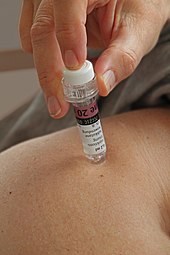Thrombosis prophylaxis
The anti-embolism or thromboembolism includes all therapeutic measures and all processes in the treatment care together that the prevention of the emergence of a thrombosis serve.
Goals and forms
A blood clot within the blood vessels called a thrombus can cause a thrombosis . Depending on the location of the thrombus, a distinction is made between arterial and venous thromboses. Thrombosis can develop in many regions of the body, but thrombosis prophylaxis measures are primarily aimed at preventing deep vein thrombosis . Thrombosis prophylaxis is intended to counteract the three causes of thrombosis, known as the Virchow triad : strengthen the venous return flow of the blood, at the same time reduce the willingness of the blood to clot and prevent damage to the vein walls. A distinction is made here between medicinal and physical prophylaxis .
Drug prophylaxis
Heparins , fondaparinux and other anticoagulants are used in the drug prophylaxis of deep vein thrombosis . Acetylsalicylic acid is only used in justified individual cases due to its insufficient effectiveness.
Physical prophylaxis
The measures of physical prophylaxis work mechanically on the legs with the aim of optimizing the blood flow. This includes nursing measures , such as supporting the patient's position , encouraging movement, and stroking and compressing the veins. When the venous diameter is reduced by external pressure in the latter process, the venous blood flow increases. For this purpose are Medical prophylaxis of thrombosis stockings (MTPS) and Intermittent pneumatic compression therapy (IPK or AIK) is used.
Indications, application and success
The prevention of thrombosis occurs primarily during a hospital stay in so-called "perioperative period," that is, before, during and after an operation . Since around 1970, drug-based thrombosis prophylaxis prior to surgical interventions has become common knowledge. Patients who have certain risk factors are particularly at risk from thrombosis. These include: paralysis , rigid bandages, rail positioning, pain-related relieving posture, heart failure , chronic venous insufficiency and vascular changes, such as B. Varicose veins . In order to select the appropriate measures, a distinction is made based on the existing risk factors into primary prophylaxis , which takes place when there is no venous disease, and secondary prophylaxis , which is used in the case of mild venous diseases and subjective symptoms.
Thrombosis prophylaxis measures aim at:
- Wrinkle-free installation of the MTPS while avoiding constrictions
- Motivation of the patient and tolerance of the measures and means of physical prophylaxis
- Ensuring venous blood flow back while lying down
literature
- Ina Brandt (ed.): Care techniques today. 2nd Edition. Elsevier Urban & Fischer Verlag, Munich 2010, ISBN 978-3-437-27091-8 , pp. 376-381.
Web links
- S-3 guidelines (for download) of the AWMF for the prophylaxis of venous thromboembolism
Individual evidence
- ↑ Dagmar repeats: Phlegm alphabet from suction to cystitis prophylaxis. 3. Edition. Urban & Fischer, Munich 2013, ISBN 978-3-437-27993-5 , p. 117.
- ↑ a b Knut Kröger: Does compression therapy still play a role in thrombosis prophylaxis today? In: Phlebologie 4/2016, pp. 230–232.
- ↑ Ernst Kern : Seeing - Thinking - Acting of a surgeon in the 20th century. ecomed, Landsberg am Lech 2000, ISBN 3-609-20149-5 , p. 63 f.

